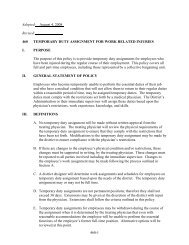Professional Learning Communities, Leadership and Student ...
Professional Learning Communities, Leadership and Student ...
Professional Learning Communities, Leadership and Student ...
You also want an ePaper? Increase the reach of your titles
YUMPU automatically turns print PDFs into web optimized ePapers that Google loves.
RMLE Online—Volume 28, No. 1Research QuestionsThe questions explored in this study were (1) What does a professional learning community look like in amiddle school? (2) What kind of principal creates a professional learning community in his/her school? (3)What are the beliefs <strong>and</strong> dispositions of such a leader? (4) Do teachers perceive their school to be a professionallearning community? (5) Is there a relationship between professional learning communities, leadership,<strong>and</strong> student learning?Methodology RationaleThe conceptual framework for this study was the concept of professional learning communities grounded inthe five disciplines of a learning organization <strong>and</strong> how democratic/constructivist middle school principals createthe conditions necessary for adult learning to improve student learning. This collective case study focusedon determining the impact of the principal on creating a professional learning community <strong>and</strong> the influence ofa professional learning community on student learning. Multiple sources of data were used to triangulate thedata. Data sources in the study included interviews with the principals, focus groups composed of teachers,<strong>and</strong> the <strong>Learning</strong> Organization Practice Profile survey administered to teachers.Participant SelectionThe study examined the work of middle school principals <strong>and</strong> teachers in six different school districts, fourschools in a large metropolitan Midwestern city <strong>and</strong> two schools in a midsize New Engl<strong>and</strong> city. Schools werechosen for two reasons. The researchers wanted to study both urban <strong>and</strong> suburban middle schools. Threeschools are in urban areas <strong>and</strong> three schools are in suburban areas. The schools will be identified as urbanschools by the letter "U" before their school's number <strong>and</strong> the suburban schools by the letter "S" before theirschool's number. The second reason these schools were chosen for the study was because the researchersknew the principals in the schools <strong>and</strong> the principals had all made public statements that they were committedto <strong>and</strong> in the process of implementing the Turning Points 2000 principles <strong>and</strong> that their schools had beenguided initially by the recommendations found in Turning Points (1989).Principals U2, U3, <strong>and</strong> U6 work in urban settings. School U2 has 575 students <strong>and</strong> 45 teachers <strong>and</strong> has beenidentified by the state as a deficient school because of test scores but is making steady progress improvingachievement scores. School U3 has 625 students <strong>and</strong> 55 teachers where the demographics have changed significantlyin the last ten years. School U3 has 61% African-American students, 1% Hispanic, <strong>and</strong> 38%Caucasian. School U6 has 652 students <strong>and</strong> 46 teachers <strong>and</strong> is considered one of the top urban schools as faras the implementation of the recommendations of Turning Points 2000 <strong>and</strong> rising achievement scores.Principals S1, S4, <strong>and</strong> S5 work in suburban settings. School S1 has 725 students <strong>and</strong> 65 teachers. The schoolin which this district is located recently made the decision to build a 6th grade center <strong>and</strong> turn their middleschools into 7th <strong>and</strong> 8th grade buildings. School S4 has 661 7th <strong>and</strong> 8th students <strong>and</strong> 54 teachers. This schoolwas awarded the Blue Ribbon School of Excellence Award in 2001-2002 <strong>and</strong> is recognized as an outst<strong>and</strong>ingmiddle school that began implementing the original Turning Points (1989) recommendations in the early1990s. School S5 has 910 students in a 7th, <strong>and</strong> 8th grade school with 69 teachers. This school is recognizedas one of the best Turning Points schools in the state.Data CollectionData for this study were collected through interviews with the principals, the <strong>Learning</strong> Organization PracticeProfile survey administered to all teachers, <strong>and</strong> focus groups with teachers. Interviews were used because ofthe type of information that the researchers wanted concerning the principal's beliefs <strong>and</strong> underst<strong>and</strong>ings ofprofessional learning communities in the context of a learning organization. The <strong>Learning</strong> OrganizationPractice Profile survey given to the staffs related to principal behavior <strong>and</strong> learning organizations because theresearchers wanted a broader range of opinions from all teachers in the school.Principal InterviewInterviewing is a basic mode of inquiry <strong>and</strong> at the heart of the interviewing research is an interest in others'individual stories because they are of worth (Seidman, 1991). Interviews with the principals were critically© 2004 National Middle School Association 6




